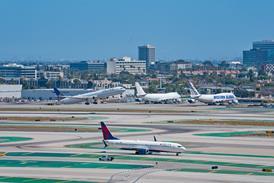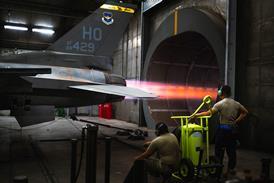NICHOLAS IONIDES SEOUL
South Korea will soon unveil its new mega-hub. Despite initial problems with debt and accessibility, Inchon is confident that its location, size and Korean liberalisation leave it well placed to compete in the region.If bigger is better, then the backers of Seoul's new Inchon International Airport must be trying for best. Built on reclaimed land 65% the size of Manhattan and costing more than $5 billion, the South Korean gateway airport is due to open in late March. As the regional economy recovers from the 1997 downturn, it hopes to be a strong draw for traffic to and through northeast Asia.
With two parallel runways in its first phase, and aesthetically attractive facilities capable of handling 27 million passengers, 1.7 million tonnes of cargo and 170,000 aircraft movements annually, it will be much roomier than Seoul's existing Kimpo airport, which is nearing saturation point. Inchon - 52km (30 miles) west of Seoul and 15km from its namesake city - will also be open 24h. This fact alone sets it apart from predecessor facility Kimpo and major competitor Tokyo Narita. Both of these hubs have overnight curfews.
Another draw is Inchon's room for expansion, according to the project's construction manager and operator, Inchon International Airport Corp (IIAC). Upon completion of all phases by 2020, it says the airport will have four main runways, enabling it to handle100 million passengers, seven million tonnes of cargo and 530,000 movements every year.
Unlike Narita, which is at capacity and has little room for expansion, Inchon has scope to grow, as it was built on a huge parcel of reclaimed land between the unpopulated Yongjong and Yongyu islands off Korea's western coast.
IIAC claims the total area of the new airport is 12 times that of Osaka's Kansai International Airport and six times that of Hong Kong International Airport (HKIA), which were also constructed on reclaimed land. Just one quarter of the land reclaimed for Inchon is being used in its first phase. The airport will open with 175,000m2 (1.9 million ft2) of cargo terminals and a single 496,000m2 passenger terminal which will hold claim to being the biggest building in South Korea. Forty-four boarding gates and 18 hardstands will allow 62 aircraft to be parked at a time, while the 3,750m- (12,300ft) long runways will allow for simultaneous departures and arrivals. IIAC says Inchon has excellent meteorological conditions, with favourable winds 98% of the time and fewer than 18 foggy days per year.
Inchon will also feature extensive conference centres, hotels, apartments, shopping malls and other facilities such as a special economic zone, as IIAC seeks to turn the reclaimed land mass into an "airport city". IIAC chairman and chief executive Kang Dong-Suk explains his aspirations: "In the 20th century, Singapore and Amsterdam Schiphol provided the best service. This century, it will be Inchon."
Financial challenge
But all is not rosy ahead of the official opening. After eight years of construction, IIAC is heavily in debt and is pleading for more government financial help. Airlines and IATA have complained about sharp increases in user charges over Kimpo. And many are unhappy over a lack of adequate transport links to the city centre - road traffic in Seoul is already a nightmare and there will be no downtown rail link until 2007. A rail link to Kimpo is not due until 2005.
Kang acknowledges difficulties but he says problems are being addressed. Financially, IIAC is seeking a major increase in government funding from the current 40% level of support: "We are asking the Government to provide more support - 60% of the total cost," Kang says. He is optimistic it will come, saying "the government is very serious and is looking very carefully at it. That will be a significant help."
Additional funding would be a major boost for the operator, which by mid-2000 had debts of 3.3 trillion won ($2.8 billion). The debt was expected to reach 4 trillion won by the end of last year.
The 60% IIAC has been required to borrow from private sources has come at a high price - interest rates average 8.5%, says Kang. Most of the funds were secured from domestic institutions at a time when the economy was in a severe downturn and lenders were in short supply. South Korea was bailed out from hardship three years ago by the International Monetary Fund, which lent it nearly $60 billion in return for promises of economic reform.
Kang says it is estimated that IIAC will need 19 years to pay back its loans, with operating profitability achieved within eight years. IIAC has meanwhile been seeking foreign strategic investors to take up to 51% - originally targeted at 30% this year and 21% more in the next. But little real progress has been made and targets have been pushed back.
Although the chief executive is confident IIAC will be privatised, there is no set timeframe for a sale and no formal talks have taken place with any party. Informal discussions, however, have been held with BAA and Frankfurt Airport, and Kang says IIAC may be willing to give up partial or full management control in the coming years.
IIAC has also been trying to settle a dispute over fees. Proposed turnaround charges for a Boeing 747-400 of $3,400 have met with opposition as they represent a 48% increase on the $2,300 charged at Kimpo.
While IIAC may be willing to compromise and lower its proposed charges, Kang believes the rates as initially planned are "very competitive". By comparison Hong Kong, Narita and Kansai charge 747 turnaround rates of between $5,000 and $9,000. The company says it can keep its charges below the others, as Inchon was built at a much lower cost - Kansai was developed for $13.5 billion and Hong Kong for $9 billion.
Chief operating officer Kim Hyo-Joon says the airport also plans to offer discounts for all-cargo flights between midnight and 05:30. No flights operate to Kimpo during these times because of the curfew: "We are going to encourage night-time operations," Kim says, adding that discounts of between 20% and 25% are likely on rates for passenger aircraft movements.
Korean liberalisation
Another way IIAC and the government are looking to draw traffic is through air liberalisation. Even its backers admit that a spacious new airport will not be enough to lure customers on its own. The Ministry of Construction and Trans-portation's director-general in charge of the government side of the airport project, Kim Se-Ho, says air services negotiators have been actively working to liberalise agreements with other countries. Seoul is in particular targeting China and Japan, home to the majority of the country's visitors, for new agreements.
South Korea's only current open-skies air accord is with the USA, but Kim says more are being sought. He concedes, however, that it will take time to convince some countries to assume a significantly liberalised stance on air rights and, until then, there will have to be a gradual easing of restrictions.
"We are trying to have more agreements with many other countries," he says, adding: "We have already made air agreements with many countries, and within that we can introduce more [liberal arrangements]. We are more aggressive than many other countries because we already have an open-skies agreement with the United States." IIAC chief Kang says the operator is supporting the strategy being pursued by the government, as: "The ideal situation is for Korea to have open skies with as many countries as possible".
He hopes the airport will benefit from its geographical position: it is well placed to connect East Asian countries with North America and Europe, and fully loaded 747-400s can reach the US East Coast without restrictions. Additionally, over 40 cities with populations of at least one million are within 3.5 hours' flying time, 26 of them in China. More immediately, Inchon authorities are seeking to assure users, who remember 1998's problems at the new Hong Kong and Kuala Lumpur airports, that the opening will proceed smoothly.
Kim, who heads the airport's operational readiness group, says special training seminars are being held for staff, while detailed passenger and baggage handling trials are being carried out and international experts are assisting with transition planning. He says planners are being conservative in preparing for the first days at Inchon. This includes not setting a firm opening date until it was clear that all systems would be ready.
The definitive date announcement, slated for January, has slipped. However, Kim says that five major handling trials are to be held by the end of February. IIAC now says the airport will open on 29 March, during the week that new airline operational schedules start. Kim also says that since Kimpo will remain open to domestic traffic, a phased opening may be decided upon rather than a single overnight move, as was done in Kuala Lumpur and at HKIA.
IIAC is soliciting advice from organisations in the USA and elsewhere, including those involved in the opening of Kuala Lumpur's new Sepang airport. Chairman Kang says IIAC has studied reports on Chek Lap Kok's opening fiasco and concluded that a lack of adequate training was a key problem.
Kang also notes that the Hong Kong hub has just one cargo terminal while Inchon has three, giving more flexibility with operations. Inchon will have a semi-automatic operational control system, unlike Chep Lap Kok which went fully automatic from day one.
In addition, he says, Inchon will be carrying out twice as many aircraft and passenger handling trials as Hong Kong, using the general public where possible rather than airline employees. Kim believes these efforts will payoff at the airport's opening. "In the technical area I don't think there will be big problems," he says with confidence.
Regardless of short-term problems and the financial difficulties facing IIAC, observers are generally positive concerning the airport's long-term prospects.
| Inchon Airport: Scheduled capacity | ||
|
| Phase I | Final Phase (2020) |
| Land Area | 1,174Ha | 4,744Ha |
| Runways | 2(3,750m X 60m) | 4(with extensions to 4,200m) |
| Passenger Terminals | 1(36.9Ha) | 2(112Ha) |
| Area of Cargo Terminals | 17.5Ha | 80.6Ha |
| Boarding Gates | 44, 16 remote | 153 |
| Check-in counters | 288 | 576 |
| Apron area | 233.8Ha | 627.4Ha |
| Aircraft Movements | 170,000 | 530,000 |
| Passengers | 27 million | 100 million |
| Cargo (metric tonnes) | 1.7 million | 7 million |
| Baggage Handling | 18,000 pieces/hour | 30,800 pieces/hour |
South Korea suffered badly during 1997's Asian economic downturn, with around a dozen carriers terminating service to Seoul and others radically reducing service. This raised fears that Inchon would be a "white elephant" on its first day of operation. However, IIAC is optimistic, as 45 airlines have already filed applications to operate to the new gateway from opening day.
Although this is fewer than the number at Kimpo before the downturn, the figure has been a long-standing target and compares with the 40 or so operators currently at Kimpo.
IIAC also says it is talking with other potential users and claims the number may soon rise to 50. Before the opening of the new hub, ageing Kimpo handled 15.5 million international passengers and 1.65 million tonnes of cargo in1999. However, the two airports are forecasting a rise to more than 20 million passengers and two million cargo tonnes this year.
By 2005 this should climb to almost 27 million passengers and 2.5 million tonnes of cargo annually, and the long term targets are to reach 36.9 million passengers and 3.43 million tonnes of cargo by 2010, finally lifting to 58.8 million passengers and 5.65 million tonnes of cargo by 2020.
As Kim says: "The success of a hub airport depends on the airlines, and not the airport." If this focus is adhered to, Inchon's future should be secure.
Source: Airline Business























